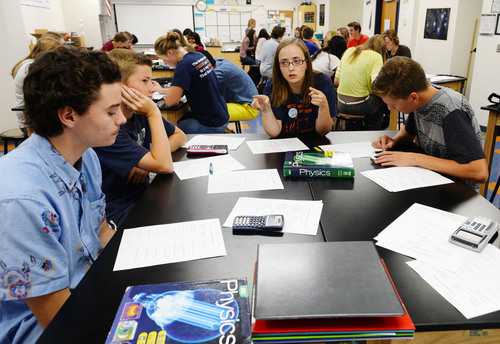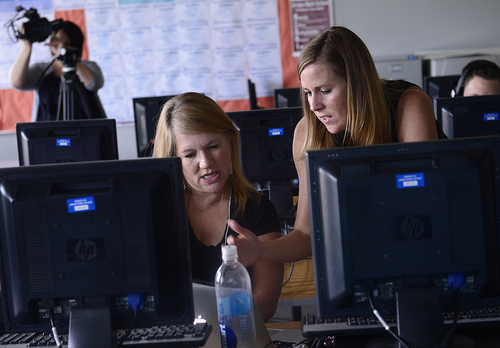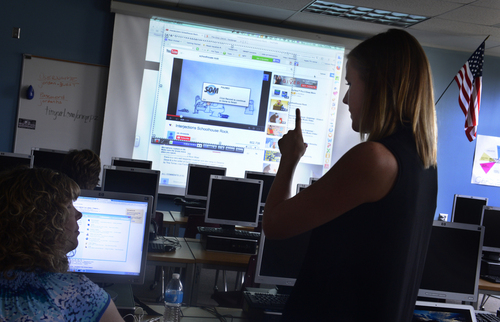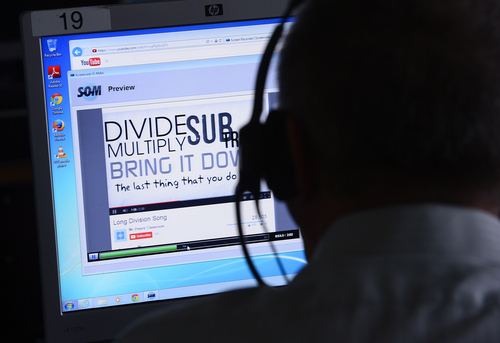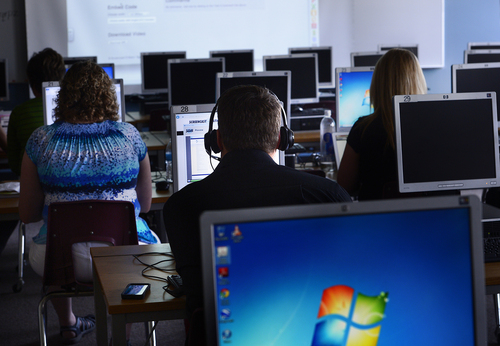This is an archived article that was published on sltrib.com in 2014, and information in the article may be outdated. It is provided only for personal research purposes and may not be reprinted.
Last school year, teacher Pam Loveridge faced her toughest group of students yet.
Within a few months, nearly 40 of her 200 middle school math students were failing — much higher than the normal two. She knew she had to do something dramatic.
So she flipped her classroom at Butler Middle School in Cottonwood Heights.
Loveridge asked students to watch her recorded lessons on computers at home, and during class, they worked on assignments they might have otherwise done as homework. Struggling students got more one-on-one attention from her during class because she wasn't busy lecturing.
Within seven weeks, only three of her students were still failing, she said.
"The time in class was much better used," Loveridge said.
The concept of flipping classrooms has gained traction in Utah and nationwide in recent years, in both lower and higher education. The idea is to expose students to new concepts at home, often through video lessons, and then to have them do work, traditionally assigned as homework, during class with the teacher's help.
Not all those who flip, of course, see the same kind of success as Loveridge. Challenges include making sure students have access to technology, actually watch lessons and that class time is used wisely. And parents are sometimes wary.
But proponents say flipping makes it easier for kids to learn at their own paces and for teachers to help students.
"They find it gives them more time to interact with students one-on-one," said Jared Ward, a Canyons District education technology specialist and an organizer of the recent Flip'in Utah conference, hosted by the district. "You're getting to have a conversation with every student about what they're learning in class."
—
Flipping fun • In some ways, it's an old idea with a new name. Many teachers and college professors have long asked students to read articles or new material at home and come to class prepared to discuss it the next day.
In other ways, however, technology has taken the concept much further. Online videos, PowerPoint presentations and websites enable students to watch entire lessons at home, pausing and rewinding as needed.
"Kids could go back and listen to pieces they might have missed," said Glen Andersen, a teacher at Red Mountain Elementary in Ivins. Andersen and his school's other fifth-grade teachers flipped their classrooms last school year.
Parents could watch videos along with their students to help them understand the lessons, rather than muddling through homework problems with them, he said.
Red Mountain parent Kristin Stout said she loved it for her fifth-grader. "If we had any questions, I was able to refer back to the video," Stout said.
Perhaps unsurprisingly, her 11-year-old son, Taran Stout, said watching a video was "more fun" than typical homework.
—
Classroom resources • At Brighton High in Cottonwood Heights, this is the third year teacher Sarah Carlson has flipped her classroom. On Friday, students in her honors physics class sat in groups completing worksheets — assigned as homework in years past — on unit conversion, scientific notation and significant figures.
Over the weekend, her students were expected to watch a video lesson Carlson created on displacement and velocity, preparing to face practice problems in class on Monday.
"When they're at home working on problems by themselves, they get stuck and frustrated and sometimes they just quit," Carlson said. "In class, they have each other as a resource, and they have me as a resource."
Brighton junior Kira Fischer said it's a strategy that works especially well for science classes.
"It's hard to figure stuff out when you're at home," Fischer said. "It's easier to watch a video and be able to rewind and go back and forth."
Brighton junior Nadia Sasivarevic said it means, "You have more time to maybe digest the information and you can ask questions of the teacher the next day."
—
'There's no one right way' • Cynthia Brame, assistant director for the Center for Teaching at Vanderbilt University, said most of the research she's seen seems to support flipping as an academically helpful strategy.
She said, however, research also shows students seem to do well when they're asked to explore a topic before they're taught new information.
"There's good evidence that the flipped classroom works but then I think there are situations where you do better to sort of prime the student before you give them that first exposure," Brame said.
"There's no very simple answer," Brame said. "There's no one right way to teach."
Teacher David Albertsen, who tried flipping his special education and math classes a bit at Matheson Junior High in Magna last school year, said he found it worked better for some students than others.
Hurdles as small as not being able to remember a password, cracked screens on mobile devices or not knowing what to do about pop-up windows proved to be barriers for some kids, he said.
The bottom line, he said, is video lessons can't replace a teacher.
"If they don't understand what the video is saying, they can pause the video and play it over again," Albertsen said, "but they can't ask the video to explain it differently."
Brighton senior Christina Ou Yang makes the same point. Some students like to ask questions during lectures, she said, and one remains unanswered during the learning process, it can be difficult sometimes to learn the next concept.
Bert Hansen, a math teacher at the Clearfield Job Corps Center who has already flipped his class, said the technique "kind of puts them in charge of their own learning." But that's only if students watch the videos, he said, and not all do, he said.
—
Aiming for engaged • Those who support flipping say there will always be some students who don't watch videos, just as some students don't do homework. Those students can watch them later in class and face consequences, they suggest.
As for the availability of technology, Andersen, at Red Mountain, said he makes DVDs of his videos for students who don't have Internet access at home. He lends DVD players to students who need them. Others say kids can use computer labs before or after school.
Questions, however, remain about the practicality of such fixes in schools with high numbers of low-income kids.
Eric Snow, an English teacher at Carbon High in Price, plans to flip his classes this coming school year when all the students at his school get Chromebooks.
His lessons will likely include having kids watch movie clips demonstrating concepts such as the monomyth (the idea that every myth with a hero has certain elements) before discussing it and writing about it in class.
Snow believes it will make his class time more interactive.
"Five minutes of engaged learning," he said, "is far better than 45 minutes of boredom and wishing you were somewhere else." —
Counting the flips
While there's no official tally, Jared Ward, a Canyons District education technology specialist, estimates at least a few hundred teachers throughout Utah have flipped their classrooms.
Nationwide, the number of teachers who have flipped a lesson jumped to 78 percent in 2014 from 48 percent in 2012, according to an online study conducted by the Flipped Learning Network and SOPHIA, an online learning and teaching company.


